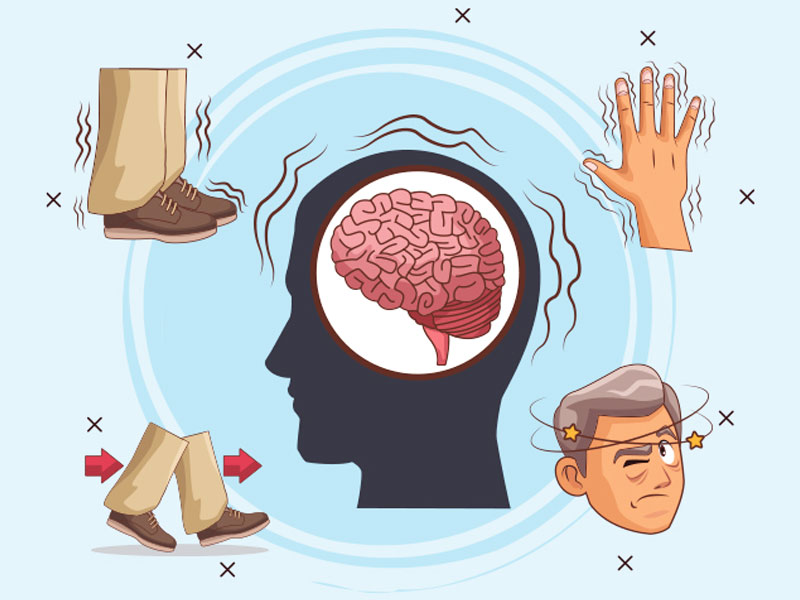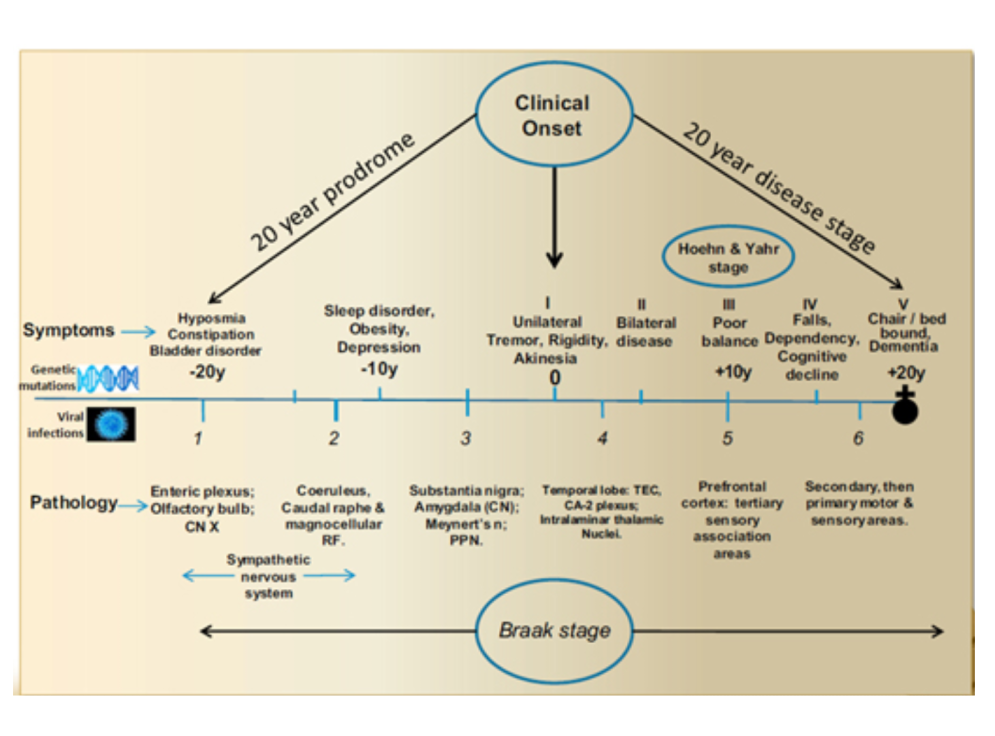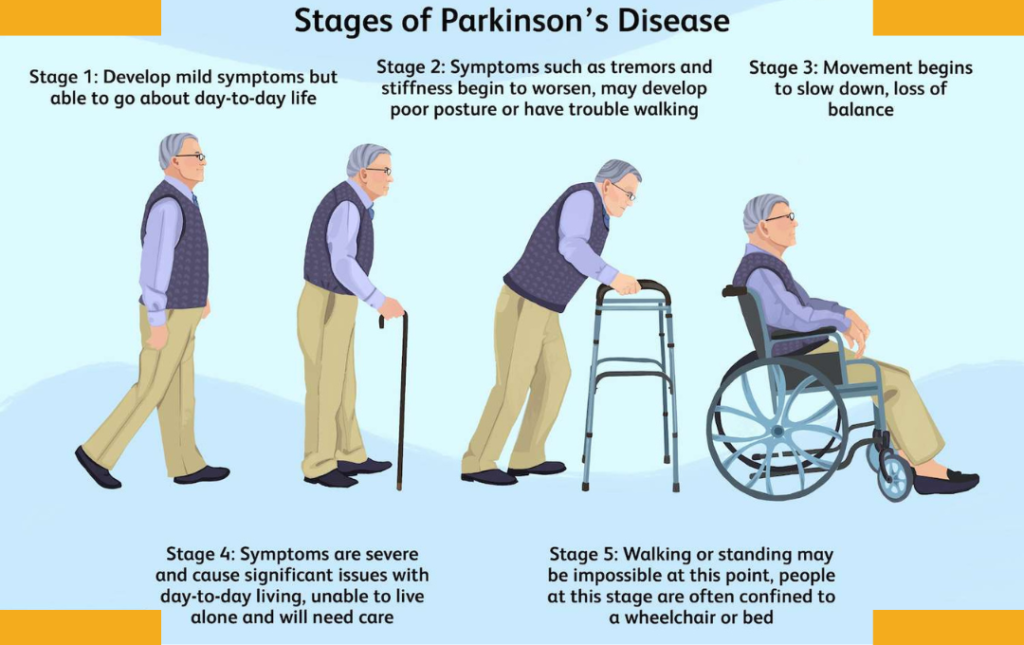Parkinson's Disease: Symptoms, Stages, Treatment, and Latest Research
Prevalence and Impact on Quality of Life
Parkinson's disease affects over 10 million people worldwide, with prevalence increasing in individuals over 60 years old. While it is more common in older adults, Parkinson's can affect younger people too, known as early-onset Parkinson's. The disease significantly impacts the quality of life, as it not only hampers physical movement but also brings cognitive and emotional challenges.
Keyword focus: Parkinson's disease, neurodegenerative disorder
Image: The Progression of Parkinson's Disease
Recognizing Parkinson's Symptoms
Parkinson's symptoms can be broadly categorized into motor and non-motor symptoms. Understanding these can help in early diagnosis and more effective management.
Motor Symptoms
Tremors: One of the hallmark signs of Parkinson's disease is a rhythmic tremor, most often in the hands, fingers, or jaw. This symptom is more prominent when at rest and can worsen over time.
Rigidity: Stiffness in the limbs or torso often reduces flexibility and can cause discomfort. Patients may feel tightness in their muscles, making routine movements challenging.
Bradykinesia (Slow Movement): Slowness of movement, or bradykinesia, is another defining motor symptom. It can make tasks like walking or even getting dressed difficult, and contributes to the shuffling gait many people with Parkinson's experience.
Postural Instability: As Parkinson's progresses, individuals may develop poor balance and coordination, leading to an increased risk of falls.
Non-Motor Symptoms
Cognitive Impairment: Many patients with Parkinson's experience difficulties with memory, attention, and decision-making as the disease progresses. This can range from mild cognitive challenges to more severe conditions like Parkinson’s disease dementia.
Mood Disorders: Depression and anxiety are common among people with Parkinson's. The emotional toll of dealing with chronic illness, combined with the brain changes caused by the disease, can lead to significant mood disturbances.
Sleep Disturbances: People with Parkinson's frequently suffer from insomnia, REM sleep behavior disorder, and excessive daytime sleepiness. Sleep disruptions can further exacerbate motor symptoms and overall fatigue.
Autonomic Dysfunction: This includes symptoms such as constipation, urinary problems, and low blood pressure. Parkinson’s disease can disrupt the body's automatic functions, leading to complications in digestion and circulation.
Keyword focus: Parkinson's symptoms, motor symptoms, non-motor symptoms
Parkinson's Disease Stages
Parkinson's disease progresses through distinct stages, which are classified using the Hoehn and Yahr scale. Understanding these stages helps healthcare providers and caregivers monitor disease progression and adjust treatment plans accordingly.
Early Stage (Hoehn and Yahr 1-2)
At this stage, mild symptoms appear, but they usually do not significantly interfere with daily activities. Patients may notice slight tremors or stiffness, but movement is generally not yet severely impacted. Often, symptoms affect only one side of the body.
Moderate Stage (Hoehn and Yahr 2.5-3)
In this moderate stage, symptoms become more noticeable. Movement difficulties, including bradykinesia and postural instability, start to affect daily life. While individuals can still manage most tasks independently, they may need help with more complex activities.
Advanced Stage (Hoehn and Yahr 4-5)
The advanced stage is characterized by severe motor impairment, where patients may require a walker or wheelchair to move around. Symptoms affect both sides of the body, and the ability to perform daily tasks becomes severely limited. In stage 5, patients may be bedridden or require full-time care.
Keyword focus: Parkinson's stages, Hoehn and Yahr
Image: Stages of Parkinson's Disease
Treatment Options for Parkinson's
While Parkinson's disease has no cure, various treatment options can help manage its symptoms and improve the quality of life.
Medications
Levodopa: This is the most effective medication for managing Parkinson's motor symptoms. Levodopa is converted into dopamine in the brain, helping to alleviate movement issues like tremors and rigidity.
Dopamine Agonists: These drugs mimic dopamine effects in the brain but are less potent than Levodopa. They can be used in early stages or alongside other medications.
MAO-B Inhibitors: These medications slow the breakdown of dopamine in the brain, helping to prolong its effect and improve motor control.
COMT Inhibitors: Used in combination with Levodopa, COMT inhibitors extend the duration of dopamine's effects by preventing its breakdown.
Surgical Interventions
Deep Brain Stimulation (DBS): DBS involves implanting electrodes in specific brain regions. The electrodes send electrical impulses that help regulate abnormal brain activity, reducing symptoms like tremors and rigidity.
Pallidotomy: This surgical procedure involves creating lesions in a part of the brain called the globus pallidus, helping to alleviate severe motor symptoms.
Lifestyle Modifications
Exercise and Physical Therapy: Regular exercise, including strength training and balance exercises, can help maintain motor skills and reduce stiffness.
Diet and Nutrition: A healthy, balanced diet can help manage symptoms, improve energy levels, and address issues like constipation.
Stress Management: Since stress can worsen symptoms, incorporating relaxation techniques such as yoga, meditation, and mindfulness can be beneficial.
Keyword focus: Parkinson's treatment, medications, surgery
Latest Research and Developments
Ongoing research continues to explore new avenues for treating and understanding Parkinson's disease. Recent breakthroughs offer hope for improved treatments and, potentially, a cure in the future.
Stem Cell Therapy
Researchers are investigating the use of stem cells to replace the damaged dopamine-producing neurons in the brain. Early studies show promise, but more research is needed to ensure its safety and efficacy.
Gene Therapy
Gene therapy aims to modify or replace faulty genes that may contribute to Parkinson's. This cutting-edge treatment could potentially slow the progression of the disease.
Immunotherapy
Immunotherapy for Parkinson's focuses on targeting the abnormal proteins in the brain, such as alpha-synuclein, that are believed to contribute to the disease's development.
Advances in DBS Technology
Image: Deep Brain Stimulation
New developments in deep brain stimulation include adaptive DBS, which adjusts stimulation in real-time based on brain activity. This makes the treatment more efficient and reduces side effects.
Keyword focus: Parkinson's research, latest developments
Living with Parkinson's Disease
Managing Parkinson’s disease requires more than medical treatment. Individuals can benefit from a combination of coping strategies, emotional support, and therapeutic interventions.
Coping Strategies
Staying active, maintaining a positive outlook, and seeking support are key to living well with Parkinson’s. Mental health is as important as physical health, and staying engaged in hobbies or social activities can help improve well-being.
Support Systems
Having a strong support system, including family, friends, and support groups, is vital. There are numerous Parkinson’s organizations that provide resources, education, and community support.
Rehabilitation and Therapy Options
Occupational therapy, speech therapy, and physical therapy can all play a significant role in improving daily functioning and maintaining independence for people with Parkinson’s.
Keyword focus: living with Parkinson's, management
Conclusion
Parkinson’s disease presents complex challenges, but advancements in treatment and research offer hope for better management and an improved quality of life. Early detection, combined with personalized care strategies, can make a significant difference in slowing the progression of the disease and maintaining independence. With continued research into new therapies, the future for those living with Parkinson’s looks promising.





Comments
Post a Comment